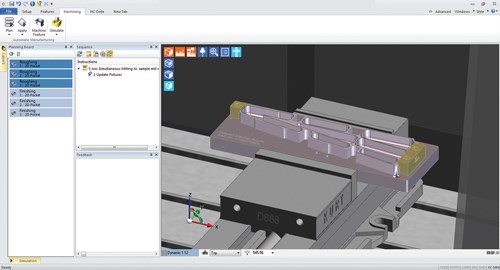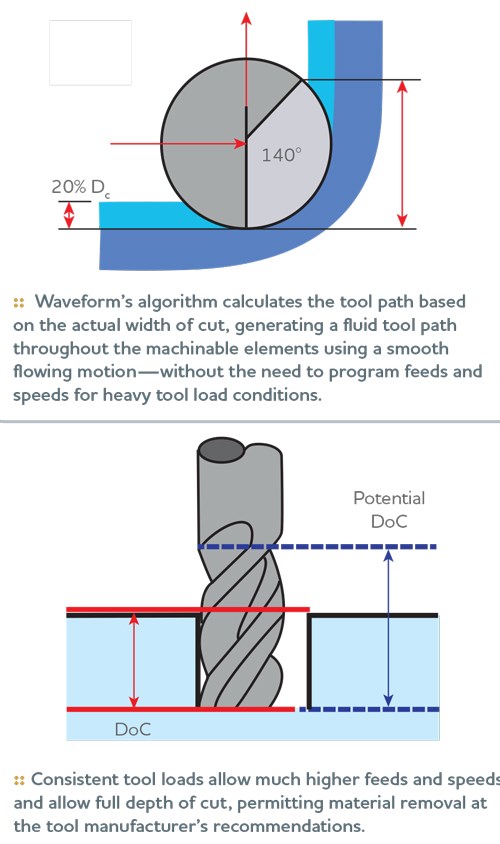Handling Machining Complexity with CAM
With the increase in demand for closer tolerances on difficult-to-machine parts, shops look to improve efficiency through simplified processes.
Not that long ago, our country faced a significant decline in certain areas of manufacturing as the lower labor costs of other countries drew much of the work away. Obviously, not all manufacturing work disappeared, but regardless of the associated extended shipping times and sometimes questionable customer support, overseas suppliers were able to offer pricing on high production work that was almost too hard to resist.
In chicken-and-egg fashion, the skilled labor force in the U.S. was getting notably thinner at roughly the same time that off-shoring was gaining steam. Older, experienced shopfloor workers were retiring or moving on to other types of jobs, and interest in manufacturing among younger workers was waning. The opportunity for transfer of knowledge from one generation to the next was starting to slip away.
Bringing Work Home
Today, much of the work that was lost overseas is now returning. A number of factors have influenced this trend, but it’s the capability to effectively and consistently produce highly accurate complex parts that ties in closely with the concerns of the skilled labor shortage. While U.S. manufacturers are working to find ways to maintain well-trained shopfloor staff, OEMs are developing more advanced machine tools to handle the increasing demands for complex parts, addressing the need for more efficient ways to manufacture to reduce costs.
Many CAM software developers are working to simplify manufacturing operations by focusing much of their design on ease of use and automating many of the processing steps. Chris Ewald (sales and services manager, Edgecam Americas, at Vero Software) notes the increasing need for setup reduction. “One of the biggest changes we’ve seen in recent years is the move to more multitasking machines,” he says. “While these machines can save significant time, they’re not necessarily easier to use. Having personnel suited to the job is important. Simplifying the programming makes this more attainable.”
The strategies that software companies are taking to address the needs of the industry can vary. They first look to support the new technologies being developed—the new machines. From there, though, each CAM supplier may take a different approach. Mr. Ewald says Vero has made a strong effort to adjust the look of its Edgecam to be more comfortable and have a familiar look in an effort to attract more people to the industry. The company calls the basic framework of its system “Workflow” because it is designed to carry the user through the programming process in a very natural progression. “We feel that many CAM interfaces are difficult to navigate,” Mr. Ewald says. “Most people are very familiar with the Windows operating system and the ribbon interface built into Microsoft Office products. We’ve designed our software to emulate that configuration. It’s structured in such a way as to guide the user along through the programming process.” Steering away from the common toolkit design, the software still provides the same tools, but points the user in a more intuitive direction for finding them.
Managing Workflow
The Workflow design has been part of the product for about 2 years and has proven to be a big draw for customers. The software engineers studied the normal process of CAM programming and incorporated the typical series of steps into the flow of the navigational elements. Mr. Ewald says, “Generally, the workflow for anyone in a programming environment begins with either producing the CAD file or receiving it from the customer. To proceed to manufacturing, a certain number of steps must be performed to program the part. The drawing or 3D model must be brought in, the part is positioned appropriately on the machine, a stock model is selected for the correct material, the fixturing is selected, and the machine tool is selected. Then, the tool paths are applied to the part. Each of these five steps can be automated for ease of use.”
Programmers sometimes need to make certain manual adjustments. Not every situation can be predicted and planned for, and these exceptions may require a very specific change from the automated sequence. Perhaps a tool may need to be moved over to allow the machine operator to access the part. “By making the software intuitive to use, we did not want to lose the ability to control everything. We’ve maintained those manual capabilities alongside the automation using the same Workflow concept,” Mr. Ewald says.
Machine tools have become far more complex through the years. At one time, a shop might have a mill and a lathe, and the two were distinctly different machines. The lines have become blurred as technology has advanced. A single machine tool commonly has both milling and turning capabilities. CAM software has been evolving as well to accommodate these changes in the equipment. Mr. Ewald says, “One of the biggest things we’ve been addressing lately is to look at the manufacturing process as machining and not necessarily as milling or turning.”
Post processors in the software can be upgraded to handle programming and simulation capabilities for specific machine models as they are released by the manufacturers. Machine graphics can be embedded in the post processor. Companies such as Vero work with their machine tool partners to keep the graphics correctly defined to provide accurate simulation and other programming specifications. The company updates the Edgecam software twice a year, and customers have the option to take advantage of these upgrades as necessary, based on their equipment needs or their desire to take advantage of other enhancements. The latest version highlights the swift changes in Workflow with more than 50 functionality enhancements, including the addition of the Waveform roughing strategy for turning.
Waveform Features
Designed for all aspects of turning, milling and mill-turn operations, Edgecam uses a shop’s in-house knowledge and experience to drive the CAM process with automation tools to suit different applications. The turning suite provides functionality for two-axis lathes, multi-turret configurations, subspindle turning centers, and mill-turn machines. On a mill-turn machine, C-, Y- and B-axis milling and drilling take place within the same environment, providing a fully integrated associative programming solution.
The software’s production milling suite provides functionality to generate efficient toolpaths from wireframe and solid geometry on a variety of machine tool configurations, ranging from two-and-a-half-axis to complex three- to five-axis milling machines.
The use of tail stocks, steadies, subspindles and twin turrets, along with C axis, CY axis and B axis are regular features on today’s multitasking machine tools. In this collision-rich environment, the software’s turning and milling combinations are designed to provide a safe machining environment.
A standard feature of the software is the Waveform roughing strategy, a high speed machining technique that maintains a constant tool cutting load by ensuring that the tool engagement into the material is consistent. The tool path moves in a smooth path to avoid sharp changes in direction, which maintains the machine tool’s velocity.
Although a concentric pattern looks relatively simple at first glance, problems arise as the tool “digs” into each corner, causing the tool to overload and lead to reduced tool life or tool breakage. In reality, the machine tool operator may have to reduce the cycle feed rate to compensate and, thus, increase the manufacturing time. As Waveform maintains a constant engagement, the feed rate can remain at the optimal value throughout the cycle.
To maintain a constant chip load, the cycle uses the philosophy of machining from “stock to part.” This method reduces the amount of intermittent cuts, particularly on external regions, which means the tool is engaged with the material longer without lifting clear. Traditionally, cycles generally offset the component until they meet the stock, leading to the generation of sharp corners and discontinuous tool paths.
For pocket regions, the tool will move into depth helically at the center and open the pocket up so that it can create a continuous spiral cut until the edge of the pocket is reached. Any remaining corners are then removed.
For more intuitive operation, the cycle uses the information in the part and post processor where possible. The interface is limited to only three modifiers that the user can adjust for the waveform pattern. The cycle can be easily applied and is integrated into the main roughing cycle.
Waveform roughing is designed to improve standard roughing by ensuring the removal of a constant volume of material. The approach also lends itself nicely to the use of high speed machining, particularly for hard materials.
Related Content
The Value of CAD/CAM and Cutting Tool Manufacturers Working Together
Overall machining efficiency can be increased when software and tooling companies combine to tackle machining challenges.
Read MoreMastercam 2024 Integrates Sandvik Coromant CoroPlus Tool Library
The integrated library enables users to work faster when importing tool geometries and cutting data.
Read MoreCAM Software’s Place Serving Emerging Trends
SolidCAM aims to align its product development and customer engagement strategies to address the evolving needs and challenges of the manufacturing industry.
Read MoreIntegrated CAD/CAM Software for Maximum Efficiency
PMTS 2023: This software solution is said to enable users to take advanced mill-turn and Swiss-type machining to new levels of speed, efficiency and simplified programming.
Read MoreRead Next
Software Creates Perfect Tool Paths for Five-Axis Machining
A week’s programming with Edgecam CNC software provides a U.K. manufacturer of orthopaedic instruments with 12 weeks of machining time for its highly complex products.
Read More5 Aspects of PMTS I Appreciate
The three-day edition of the 2025 Precision Machining Technology Show kicks off at the start of April. I’ll be there, and here are some reasons why.
Read MoreDo You Have Single Points of Failure?
Plans need to be in place before a catastrophic event occurs.
Read More














.jpg;maxWidth=300;quality=90)










